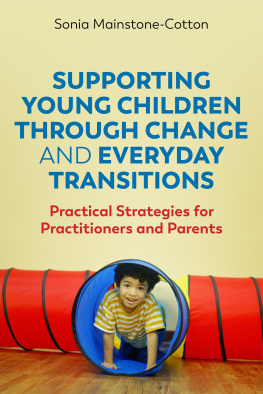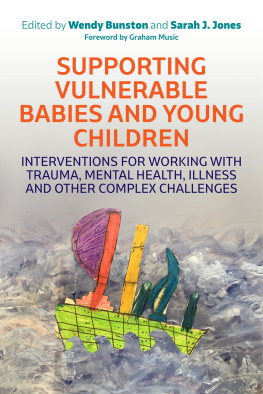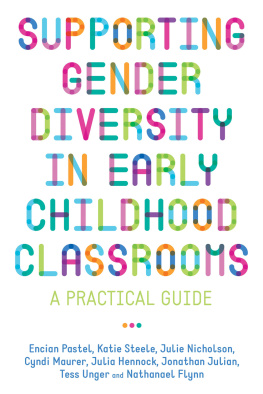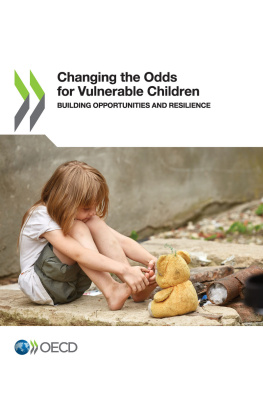SUPPORTING
VULNERABLE CHILDREN
IN THE EARLY YEARS
Practical Guidance and Strategies
for Working with Children at Risk
Edited by PAT BECKLEY
Foreword by Professor Chris Atkin
Jessica Kingsley Publishers
London and Philadelphia
Contents
Foreword
Professor Chris Atkin
It can be argued that any child has the potential to be at risk. This book explores specific types of experience that make a child vulnerable, events that affect a childs life and ongoing circumstances that present risk. Contemporary research is used by Yinka Olusoga, Antony Luby and Elizabeth Farrar to provide a detailed overview of the different ways children learn. This includes the contemporary environment and indoor and outdoor approaches. The challenges and strategies used in rural school settings are discussed by Nishi Bremner and learning outdoors by Beverley Keen. Rosey Shelbourne, Gina Taylor, Sarah Howe and Helen Thornalley identify strategies to support young children and keep them safe. Vulnerable groups are considered by Julia Lindley-Baker and Pat Beckley, while Pat, Margaret Simms, Julie Percival, Anne Renwick and Emmy Sealey suggest ways to promote health and wellbeing, transition experiences and the role of the family and wider community in supporting vulnerable children. The contributors are experts in their field with backgrounds in academic research, schools and psychology. The book furthers our understanding, giving insights into childrens worlds, while suggesting positive ways to support young children in society.
Professor Chris Atkin
Professor of Higher Education
School of Teacher Development
Head of the Centre for Public Policy and Professional Practice in Education
Bishop Grosseteste University
Lincoln, UK
Introduction
Arguably, all children have the potential to be vulnerable. Parents, carers and those in the community care for them, but some children live in challenging circumstances or are made vulnerable by difficulties or events that occur. Obtaining the numbers of those vulnerable can be very difficult, as the situation is constantly changing and young children may be classed as vulnerable for many different reasons, with some involved in more than one area of vulnerability. The challenging situations that children may be experiencing can vary from complex, life-changing cases to those requiring ongoing support to maintain appropriate learning, development and progress.
Children may be in a family group where there is an environment that includes such factors as regular substance misuse, physical abuse or neglect. They may experience economic issues, for example poverty or homelessness. A Special Education Need and/or Disability (SEND) could give rise to vulnerability, while unexpected events, such as the death of a parent, could cause a child to become vulnerable as the situation at home may become unstable and insecure. Ongoing risks, for example safety and safeguarding issues, are ever present and continual potential dangers give rise to strategies to ensure they do not arise. Children therefore live in a society that seeks to keep them safe and protected, while possibly limiting their experiences and awareness of the world around them for fear of the dangers it may pose.
This book seeks to explore issues concerning the vulnerability of children and is organised in four parts. In Part 1, The Contemporary Environment, Yinka Olusoga considers theorists and factors that influence childrens views of the world and educational approaches giving them the ability to promote their agency and decision-making. In then observes the challenges faced in a rural setting and presents approaches to enable partnerships to work together to enhance life chances for children.
Part 2 considers some of the groups that make up vulnerable children. This includes Julia Lindley-Bakers experiences of vulnerable children, language and poverty, as explored by Elizabeth Farrar, and children in a diverse society and looked-after children, discussed by Pat Beckley in , drawing on her work in inner-city schools and settings.
Ways of supporting the child are considered in Part 3, including safeguarding based on Rosey Shelbournes extensive work in Uganda, interventions by Gina Taylor in her role as Foundation Stage Coordinator, feedback approaches used by Sarah Howe and Helen Thornalley when teaching and the outdoors by Beverley Keen, where differing teaching and learning styles and approaches can be accessed.
Part 4 includes consideration by Pat Beckley of health and wellbeing as a foundation for lifelong personal, social and emotional stability. Positive transitions are analysed by Margaret Simms who considers how these changes impact on childrens lives. The section is completed with a collaboration from Julie Percival, Anne Renwick and Emmy Sealey in a discussion of the child and identity in the family and wider community. Childrens vulnerability is a continuing issue for concern, with challenges for families and communities. With deeper insights into these issues, strategies can be sought to attempt to support children as they grow and give them a positive foundation for their future lives.
PART 1
The Contemporary
Environment
CHAPTER 1
The Contemporary
Environment
Yinka Olusoga
Course Leader, PGCE Primary Education (37), leading to QTS
Leeds Beckett University
Chapter overview
The term vulnerable children is now in common use in statutory legislation, non-statutory guidance, reports and processes relating to the care and education of children. It is drawn upon by politicians, by professionals working in care, education, health and social care and by campaigners and charities who advocate for children and families. It is the focus of research by academics working in a range of disciplines. Vulnerable children have been the focus of official reports. The most recent is from the office of the Childrens Commissioner for England (Childrens Commissioner for England, 2017b), which sets out to count and to categorise vulnerable children in England. Debate rages regarding how best to address vulnerable children in policy, practice and research.
This chapter will examine how the term vulnerable children has come to be so prominent in policy and debates around practice and will consider what the term actually means. It will also explore how within vulnerable children as an umbrella term, different categories of vulnerability have been identified and how these categories map onto childrens real-life experiences. Alongside vulnerability, it will scrutinise how key related terms such as adversity and risk inform current understandings of vulnerability and how that impacts on policy and practice. This discussion will consider how critical research into children and childhood has challenged traditional concepts and practices that underpin approaches to working with, and advocating for, children.
Finally, the chapter will examine the implications for the early years sector in recognising and addressing the needs and rights of vulnerable children and their families in our practice and settings. This will include considering how research and theory can help us to critically reflect on and develop policy and practice in the current educational climate.
The journey to the contemporary context: policies and politics
In 21st-century Britain, the popular argument as far as children and childhood are concerned is that it is both the best of times and the worst of times. Childhood is physically safer than ever before. Children are less likely to die in early infancy; they are more likely than previous generations to finish their schooling and to go on to gain a university education (Bolton, 2012; NSPCC, 2014; Wolfe et al. , 2014). However, not all children have an equal chance at these positive experiences and outcomes. Child poverty rates, rather than decreasing as they did across most of the 20th century, since 2013 have been once again on the rise (Ivinson et al ., 2017a, p. 8). In their 2010 book, The Spirit Level , Wilkinson and Pickett highlight the growing size of the income gap between the richest 20 per cent of the population and the poorest 20 per cent, arguing that this is leading to Britain becoming an increasingly socially divided country (cited in Ivinson et al ., 2017b, pp. 6 and 18). Furthermore, unlike previous generations, the life expectancy of some of todays children may be lower than their parents, due to diet and lifestyle factors (Olshansky et al. , 2005). As a generation, children are less likely to experience free, unstructured play outside the home (Loebach and Gilliland, 2016). They are exposed to outside influences via technology and social media that, as well as bringing them opportunities to absorb and contribute to the cultural landscape, also open them up to potential harm.














